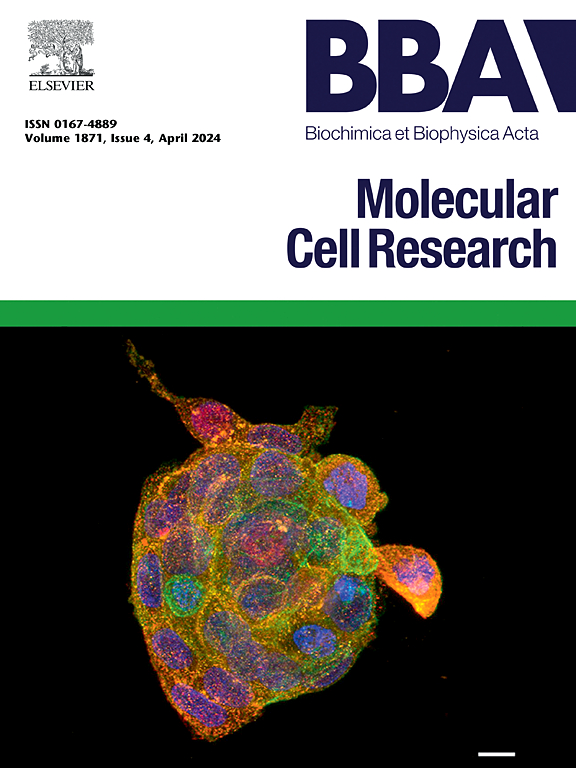POLR1D, a shared subunit of RNA polymerase I and III, modulates mTORC1 activity
IF 3.7
2区 生物学
Q1 BIOCHEMISTRY & MOLECULAR BIOLOGY
Biochimica et biophysica acta. Molecular cell research
Pub Date : 2025-04-12
DOI:10.1016/j.bbamcr.2025.119957
引用次数: 0
Abstract
The mechanistic target of rapamycin complex 1 (mTORC1) is a crucial nutrient sensor and a major regulator of cell growth and proliferation. While mTORC1 activity is frequently upregulated in cancer, the mechanisms regulating mTORC1 are not fully understood. POLR1D, a shared subunit of RNA polymerases I and III, is often upregulated in colorectal cancer (CRC) and mutated in Treacher-Collins syndrome. POLR1D, together with its binding partner POLR1C, forms a dimer that is believed to initiate the assembly of the multisubunit RNA polymerases I and III.
Our data reveal an unexpected link between POLR1D and mTORC1 signalling. We found that the overproduction of POLR1D in human cells stimulates mTORC1 activity. In contrast, the downregulation of POLR1D leads to the repression of the mTORC1 pathway. Additionally, we demonstrate that a pool of POLR1D localises to the cytoplasm and interacts with the mTORC1 regulator RAGA and RAPTOR. Furthermore, POLR1D enhances the interaction between RAPTOR and RAGA and sustains mTORC1 activity under starvation conditions.
We have identified a novel role for the RNA polymerase I/III subunit POLR1D in regulating mTORC1 signalling. Our findings suggest the existence of a new node in the already complex mTORC1 signalling network, where POLR1D functions to convey the cell's internal status, namely polymerase assembly, to this kinase.
POLR1D是RNA聚合酶I和RNA聚合酶III的共享亚基,可调节mTORC1活性
雷帕霉素复合体1 (mTORC1)是一个重要的营养传感器和细胞生长和增殖的主要调节剂。虽然mTORC1活性在癌症中经常上调,但调控mTORC1的机制尚不完全清楚。POLR1D是RNA聚合酶I和RNA聚合酶III的共享亚基,在结直肠癌(CRC)中经常上调,并在叛逆-柯林斯综合征中发生突变。POLR1D与其结合伙伴POLR1C形成二聚体,据信可以启动多亚基RNA聚合酶I和III的组装。我们的数据揭示了POLR1D和mTORC1信号之间意想不到的联系。我们发现人类细胞中POLR1D的过量产生会刺激mTORC1的活性。相反,POLR1D的下调导致mTORC1通路的抑制。此外,我们证明了一组POLR1D定位于细胞质,并与mTORC1调节因子RAGA和RAPTOR相互作用。此外,POLR1D增强了RAPTOR和RAGA之间的相互作用,并在饥饿条件下维持mTORC1的活性。我们已经确定了RNA聚合酶I/III亚基POLR1D在调节mTORC1信号传导中的新作用。我们的研究结果表明,在已经很复杂的mTORC1信号网络中存在一个新的节点,POLR1D的功能是将细胞的内部状态(即聚合酶组装)传递给该激酶。
本文章由计算机程序翻译,如有差异,请以英文原文为准。
求助全文
约1分钟内获得全文
求助全文
来源期刊
CiteScore
10.00
自引率
2.00%
发文量
151
审稿时长
44 days
期刊介绍:
BBA Molecular Cell Research focuses on understanding the mechanisms of cellular processes at the molecular level. These include aspects of cellular signaling, signal transduction, cell cycle, apoptosis, intracellular trafficking, secretory and endocytic pathways, biogenesis of cell organelles, cytoskeletal structures, cellular interactions, cell/tissue differentiation and cellular enzymology. Also included are studies at the interface between Cell Biology and Biophysics which apply for example novel imaging methods for characterizing cellular processes.

 求助内容:
求助内容: 应助结果提醒方式:
应助结果提醒方式:


